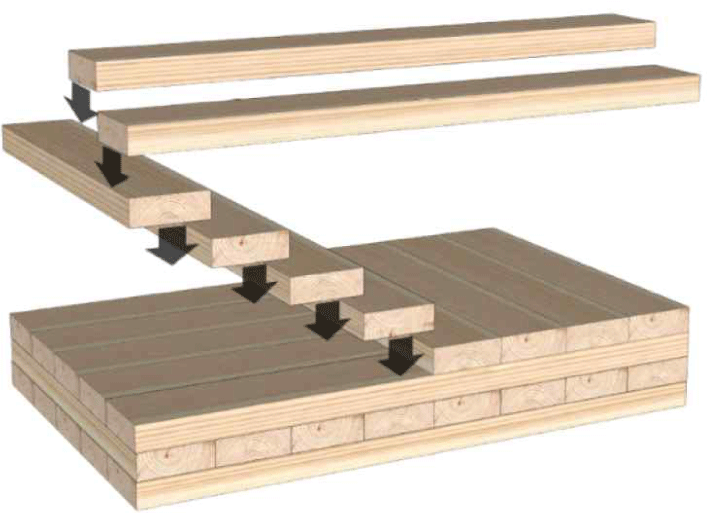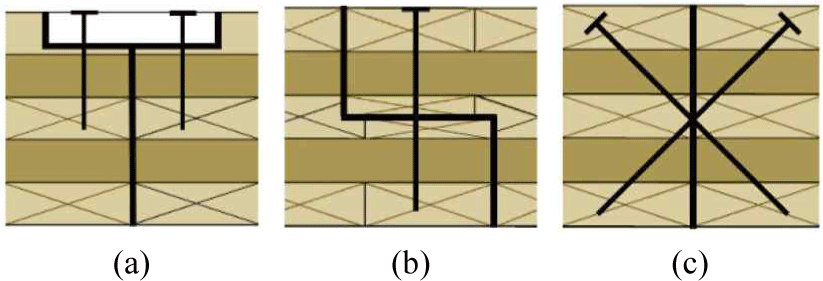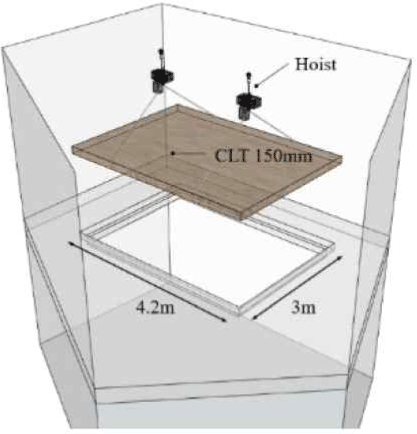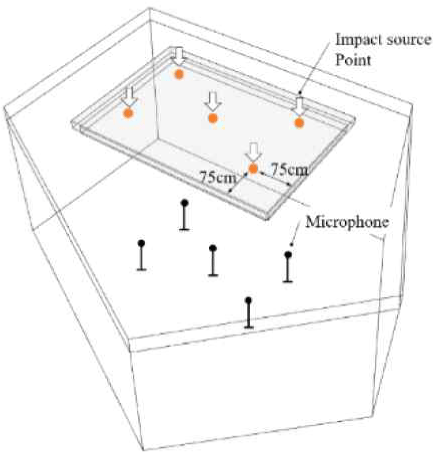1. INTRODUCTION
The Housing Act in South Korea clearly defines the criteria for noise levels between floors in residential buildings with 30 or more residences (Ministry of Land, Infrastructure and Transport, 2022). It stipulates that the noise level should not exceed 49 dB for both lightweight floor impact sound, caused by light and hard impacts, and heavyweight floor impact sound, resulting from heavy and soft impacts. A study assessing the sound insulation performance of a 210 mm concrete bare slab for heavyweight floor impact estimated the performance rating as 53 dB (LiFmax,Aw; Kim et al., 2004). Based on this study, the specified criteria was set at a significantly high level of performance. This same performance criterion has been applied when constructing a timber structure for an apartment building with 30 or more residences.
In recent times, there has been a growing body of research exploring the utilization of Korean domestic timber for the production of cross-laminated timber (CLT) or various timber materials for wooden architecture, driven by the goals of achieving carbon neutrality and efficient utilization of forest resources (Di Bella and Mitrovic, 2020; Hwang et al., 2022; Oh, 2022; Oh et al., 2017; Song and Kim, 2023; Yang et al., 2021). Some studies have also delved into the thermal insulation performance of CLT (Pang et al., 2017) or the sound absorption coefficient and sound transmission loss of various timber materials (Jang, 2022a, 2022b, 2022c, 2022d, 2022e; Kang et al., 2019). However, the majority of studies on CLT in South Korea have focused on its production and mechanical performance, with only a few examining its floor impact sound insulation performance when used domestically as a floor material (Jang and Lee, 2019; Jung et al., 2020; Lee et al., 2022; Pang et al., 2021; Song and Kim, 2022). In contrast, some overseas studies on CLT have explored the sound insulation performance of CLP slabs. For instance, in a study employing 180 mm, 5-ply CLT panels, the estimated sound insulation performance for lightweight floor impact was 86 dB (Vardaxis et al., 2022). In another study employing 175 mm, 5-ply CLT panels and 245 mm, 7-ply CLT panels, the estimated sound insulation performance for lightweight floor impact was 85 dB and 80 dB, respectively (Zeitler et al., 2014). Nonetheless, since previous studies primarily focused on light-weight wood frame structures (Lee and Jang, 2023) and heavy timber structures, there is a pressing need to assess the floor impact sound insulation performance of domestic CLT.
Techniques for reducing floor impact sound include implementing a heavy-weight and high-stiffness floor system that restrains floor slab vibrations resulting from impacts, a floating floor system that prevents the transmission of impact-related vibrations or energy to the floor slab, and a double ceiling system that blocks the radiation of impact-related sound from the floor slab (Yang, 1998). This study focused on the heavy-weight and high-stiffness floor systems at first, prior to the development of floating floor and double ceiling systems, in order to evaluate the floor impact sound insulation performance of the bare CLT slabs themselves. The influencing factors considered in this study with regard to the weights and stiffnesses of CLT slabs included specific weights, joint types, and thicknesses of CLT. The classification of tree species in the Korean Standards (KS) F 2081 defines Group A as species with a dry specific weight of ≥ 0.55 and Group B as species with a dry specific weight ranging from 0.5 to 0.55. Consequently, Larix kaempferi and Pinus densiflora were chosen as representative tree species of Groups A and B, respectively to analyze the impact of specific weights by the species. Moreover, the primary joint types for CLT are spline, half-lap, and butt joint, with variations in fastener angle and spacing, and CLT cross-section depending on the joint types. These variations in joint types can result in differences in vibration behavior, affecting sound leakage or the excitation of impact sources. To ascertain the effect of joint types on the floor impact sound insulation performance, a comparison was made among these three joint types. Additionally, the results were analyzed according to variations in weights achieved by altering the CLT thickness (150, 300, and 450 mm). In this study, the floor impact sound insulation performance of domestic CLT panels was collectively offered by taking into account CLT joint types, tree species, and thicknesses.
2. MATERIALS and METHODS
The timbers used in this study were Korean domestic L. kaempferi and P. densiflora timbers with dimensions of 130 mm width, 30 mm thickness, and 3,600 mm length. These timbers were sourced from the Central Timber Distribution Headquarters of the National Forestry Cooperative Federation. In the production of CLT, 1,716 pieces of L. kaempferi laminae and 1,016 pieces of P. densiflora laminae, each dried to a mean moisture content of 12%, were employed. The grading was carried out in accordance with KS F 3020 (Korean Standards Association, 2018b), utilizing a machine grader (MGFE-251, IIDA Kogyo, Komaki, Japan) available at the Central Timber Distribution Headquarters (Fig. 1). Based on the grading result, it was determined that C-E10-E8 and C-E8-E6 (off-grade) grades should be applied to Larix CLT and Pinus CLT, respectively. The subsequent production process, including, adhesive application, and pressing, was conducted in accordance with KS F 2081 (Korean Standards Association, 2021b).
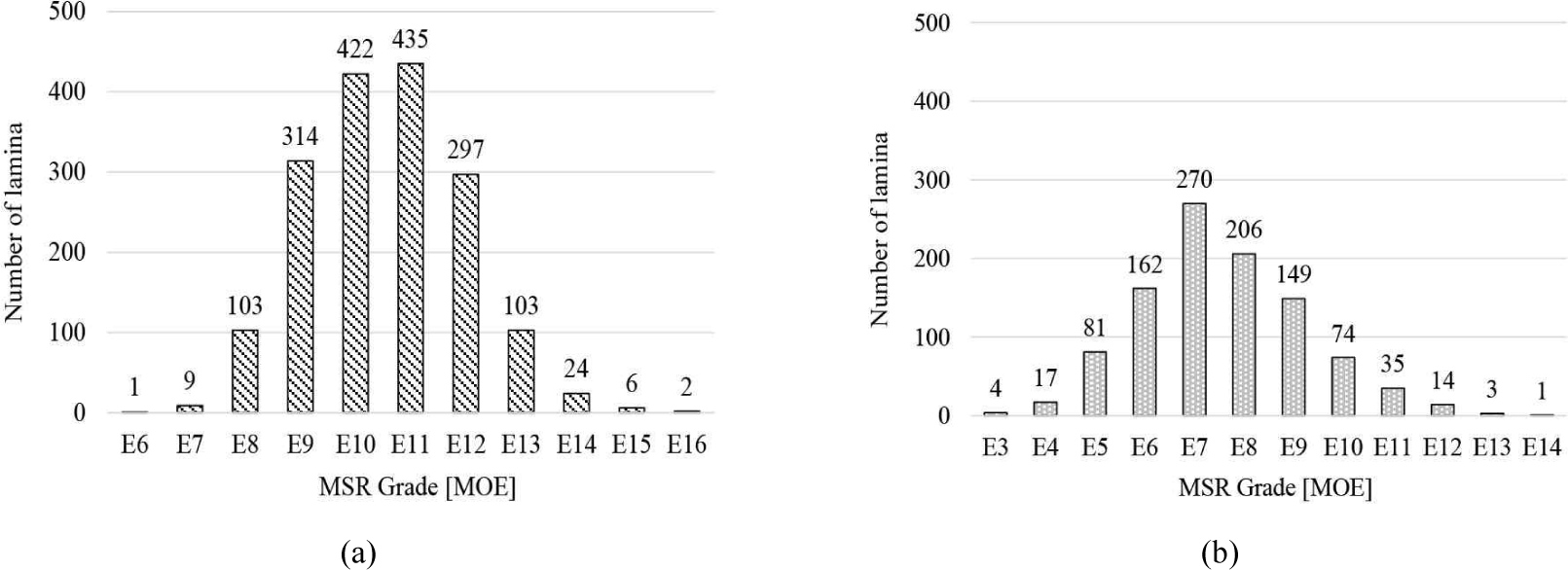
For the longitudinal joint, finger jointing was performed following KS F 3023 guidelines (Korean Standards Association, 2018a). In finger jointing, the distance between the finger bone and the knot center was set to three times the knot radius. Diphenylmethane 4,4'-diisocyanate was used as the adhesive in finger jointing.
The adhesive used in the CLT production was PRF (Phenol - Resorcinol - Formaldehyde). A quantity of 200 g/m2 was applied for each cross-section. The press pressure was set at 1 MPa, followed by a 20-hour pressing period and an additional week for curing.
Regarding lamina layup, an outer layer - inner layer configuration was employed in line with KS F 2081 standard. The inner layer encompassed all laminae excluding the outer laminae. In this study, 5-ply (150 mm) panels were produced, comprising two outer and three inner laminae layers.
The CLT panels manufactured by cross-stacking the major-axis laminae and minor-axis laminae from the outer layer, as depicted in Fig. 2. The specific weights of the produced CLT panels were 0.587 for L. kaempferi and 0.476 for P. densiflora. Calculated for the 150 mm thickness, the areal density for each tree species was 88.1 kg/m2 for L. kaempferi and 71.4 kg/m2 for P. densiflora. The overall dimensions of the CLT slabs were set at 3 m in width and 4.2 m in length for both tree species, achieved by joining three panels of 1 m × 4.2 m, aligned with the size of the test specimens.
CLT sizes can be adjusted as needed at the construction site through various jointing methods. In this study, three common joint types: spline, half-lap, and butt, were employed for inter-panel joints to compare the effects of the CLT joint types. Fig. 3 illustrates these three joint types, with the screws for jointing sourced from Rothoblass: (a) HBS screws of 6 mm diameter and 80 mm length were utilized in the spline joints; (b) HBS screws of 6 mm diamter and 130 mm length were used in the half-lap joints; (c) VGZ screws of 180 mm length were cross-driven at a 45° angle in the butt joints. The spacing, edge distance, and end distance of the screws were set to meet the minimum requirements specified in the manufacturer’s specifications, as displayed in Table 1. While timber’s mechanical performance, such as shear performance, varies depending on the joint type, this study primarily focused on sound insulation performance, examining acoustic aspects such as the sound bridge phenomenon arising from the cross-section types and screws at the joints.
| Type | End distance | Edge distance | Screw spacing (transverse) | Screw spacing (longitudinal) |
|---|---|---|---|---|
| Spline | 150 | 30 | 60 | 150 |
| Half-lap | 75 | - | - | 75 |
| Butt | 100 | 75 | 150 | 200 |
All measurements adhered to the KS F ISO 10140-3 floor impact sound laboratory measurement methods (Korean Standards Association, 2021a). The experiments were conducted in two top-to-bottom atypical reverberation rooms, as depicted in Fig. 4. A CLT slab measuring 3 m in width and 4.2 m in length was placed at the center of the room using hoists. As shown in Fig. 5, impact sources were applied at five points, including the center of the source excitation room (top floor), while the other four were positioned 75 cm away from the slab borders. Five microphones were placed at a height of 1.2 m in the sound receiving room (bottom floor).
The impact sources used in the experiment according to KS F ISO 16283-2 standard (Korean Standards Association, 2015) are illustrated in Fig. 6: (a) a rubber ball served as the heavy-weight impact source to simulate heavy and soft impacts, such as human footfalls. The ball measured 185 mm in diameter and 30 mm in thickness, constructed from silicon rubber material with a hollow interior. The impact sounds of approximately 1,500 N were generated by freely dropping a 2.5 ± 0.2 kg ball from a 1 m height. The characteristics of the impact source generated by the rubber ball are presented in Fig. 7(a). The impact source’s strength is most pronounced at 63 Hz within the tested frequency range, tapering off towards 500 Hz. Fig. 6(b) showcases the tapping machine used as the light-weight impact source to simulate relatively light and hard impacts, such as heel tapping. The tapping machine featured five hammers of 500 g arranged in a straight line, generating impact sounds as hammers sequentially fell 10 times per second. The characteristics of the impact source produced by the tapping machine are detailed in Fig. 7(b). It’s noteworthy that the impact source encompasses moderate to high ranges within the tested frequency band (Lietzén et al., 2021).
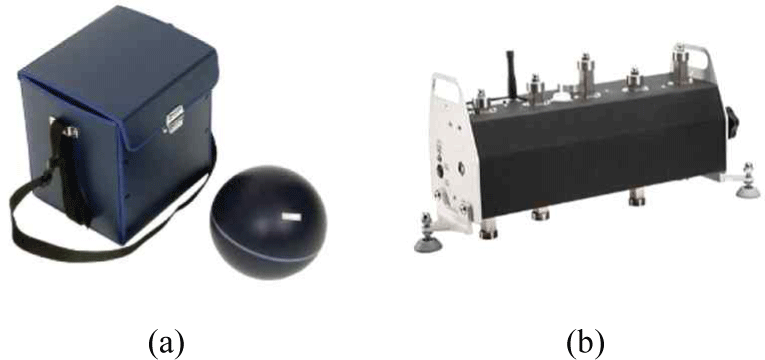
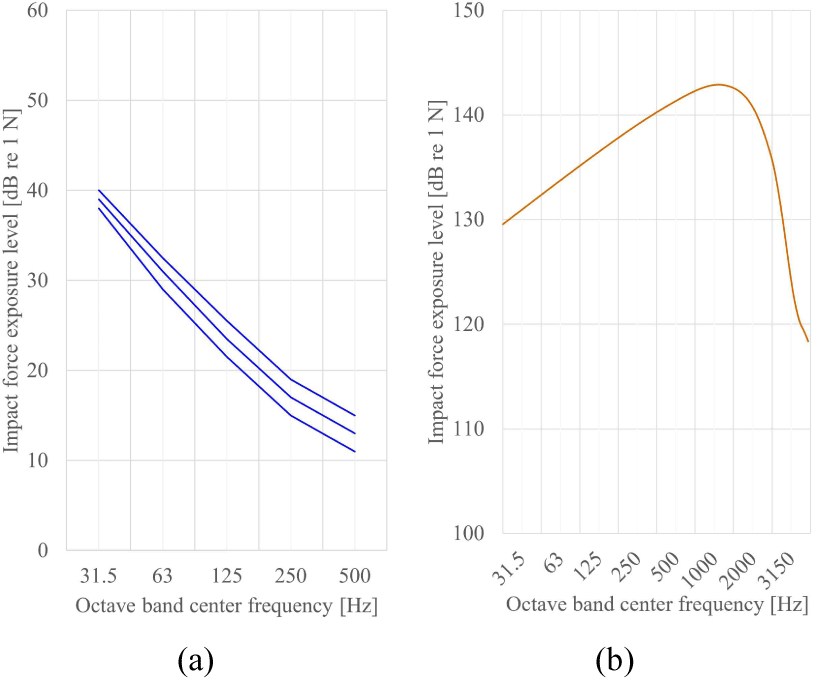
The experiment employed the following devices, and Table 2 provides information on the eight CLT floor slabs used in the study.
Floor impact sound evaluation was conducted based on the KS F ISO 717-2 standard (Korean Standards Association, 2020). The frequency band for heavy-weight floor impact sound was 50–630 Hz, and for light-weight floor impact sound, it was 100–3,150 Hz, both analyzed at 1/3 octave band. The single-number quantity for heavy-weight floor impact sound (LiA,Fmax) was calculated using Equation (1), while that of light-weight floor impact sound (LnT,w) was calculated using Equations (2) and (3).
Aj: A-weighting correction for one-third octave band
T0: Reference reverberation time (0.5 s)
T: Reverberation time in the receiving room (s)
L’nT: Standardized impact sound pressure level (dB)
Li: Sound pressure level measurements at five microphones
3. RESULTS and DISCUSSION
Fig. 8 displays the single-number quantities of heavy-weight and light-weight floor impact sounds (LiA,Fmax and LnT,w) according to joint types. As depicted in the figure, the single-number quantities exhibited variations within 1 dB for both L. kaempferi slabs (LS, LH, and LB) and P. densiflora slabs (PS, PH, and PB).
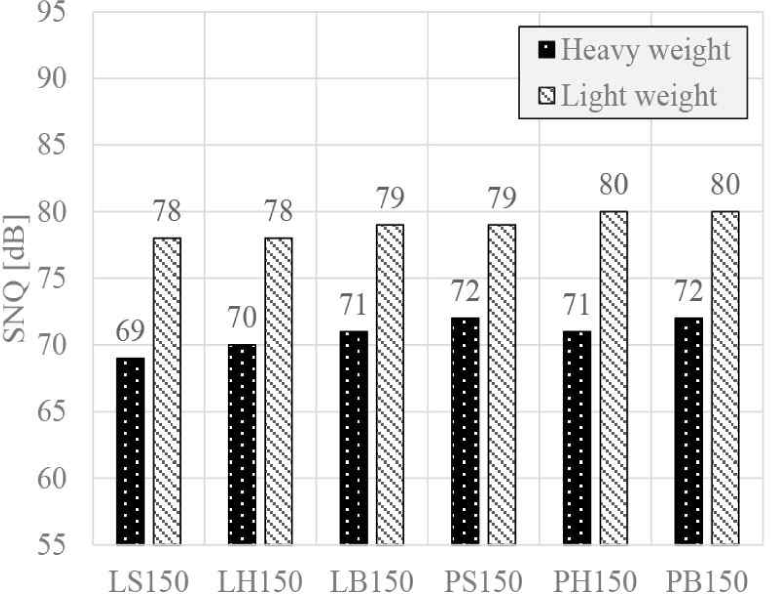
Fig. 9 represents the measured values by frequency according to joint types. For heavy-weight floor impact sounds, as illustrated in Fig. 9(a) and (b), the sound pressure level was high in low frequency range, followed by a decreasing trend toward middle to high frequency ranges. In the case of light-weight floor impact sounds, as shown in Fig. 9(c) and (d), the sound pressure was high at middle to high frequency ranges. This result can be attributed to the characteristics of each impact source.
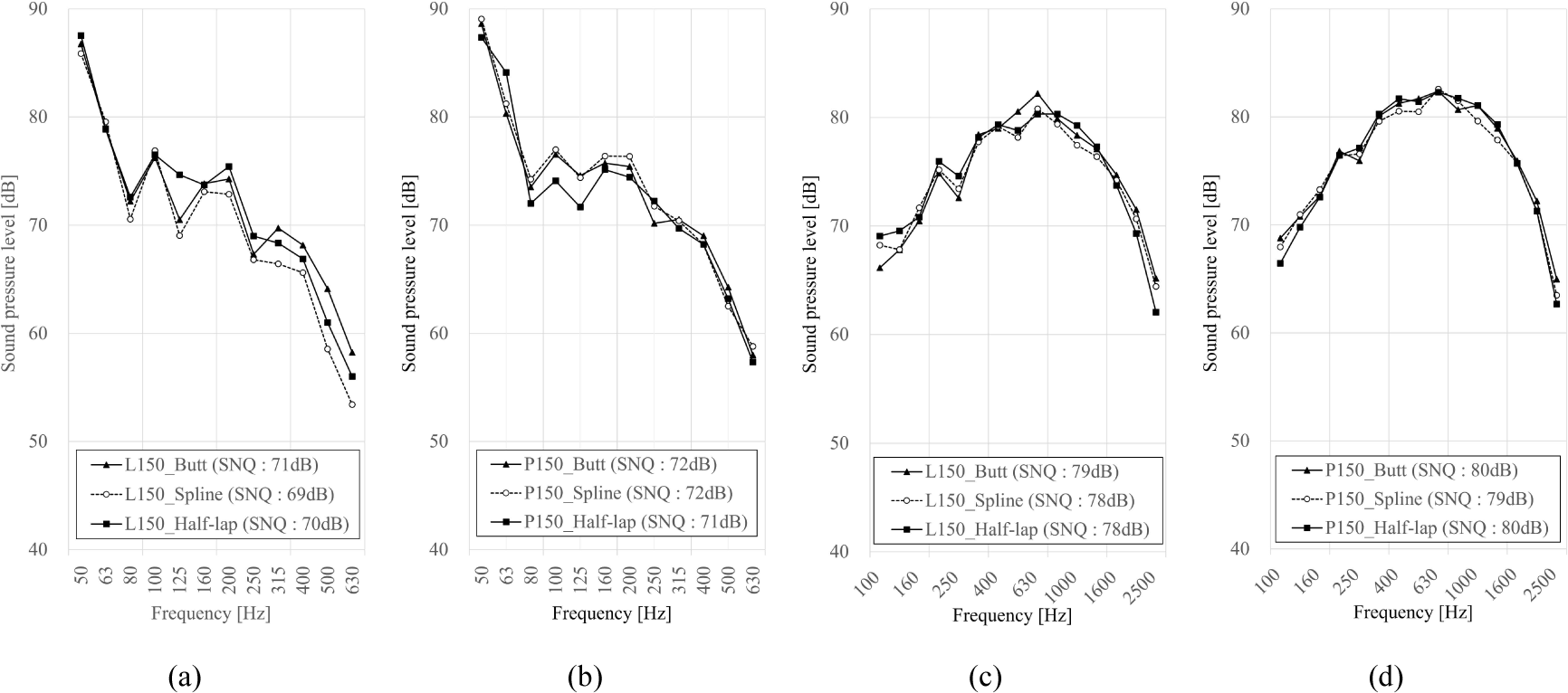
Regarding the heavy-weight floor impact sound insulation performance of L. kaempferi based on joint types [Fig. 9(a)], the variation across measured values was approximately 5 dB at 125 Hz. For P. densiflora [Fig. 9(b)], the variation was around 3 dB at 80–125 Hz. As for light-weight floor impact sound insulation performance [Fig. 9(c) and (d)], the variation ranged from 1 to 3 dB at all frequency bands for both tree species. However, since the observed variation did not consistently align with the change in tree species, it is challenging to interpret this result as a unique property resulting from joint type. Additionally, despite variations occurring within 1–5 dB by frequency, the difference amounted to only approximately 1 dB in terms of single-number quantity.
In this study, a difference of ≤ 4 dB was considered to have an insignificant effect on floor impact sound insulation performance. This consideration aligns with the approved 4 dB intervals for the grading of floor structures outlined in the current Housing Act and a previous study demonstrating that the just noticeable difference, which refers to the perceptible level of heavy-weight floor impact sound by the auditory system, is 4 dB (Jeong, 2021).
The single-number quantity difference of 1 dB observed according to joint types is likely due to the close connection at the inter-panel joint through screw fixation, resulting in a single planar behavior. Therefore, joint types were shown not to have a significant effect on floor impact sound.
Based on the results presented in 3.1.1., which indicate the lack of an effect of joint types on floor impact sound, the measured values according to joint types were averaged for each tree species, as shown in Fig. 10. For 150 mm CLT, the mean single-number quantities for heavy-weight floor impact sound (LiA,Fmax) were 70 dB for L. kaempferi and 71.7 dB for P. densiflora. The mean single-number quantities for light-weight floor impact sound (LnT,w) were 78.3 dB for L. kaempferi and 79.7 dB for P. densiflora. Both heavy-weight and light-weight floor impact sounds exhibited variations within 1 dB.
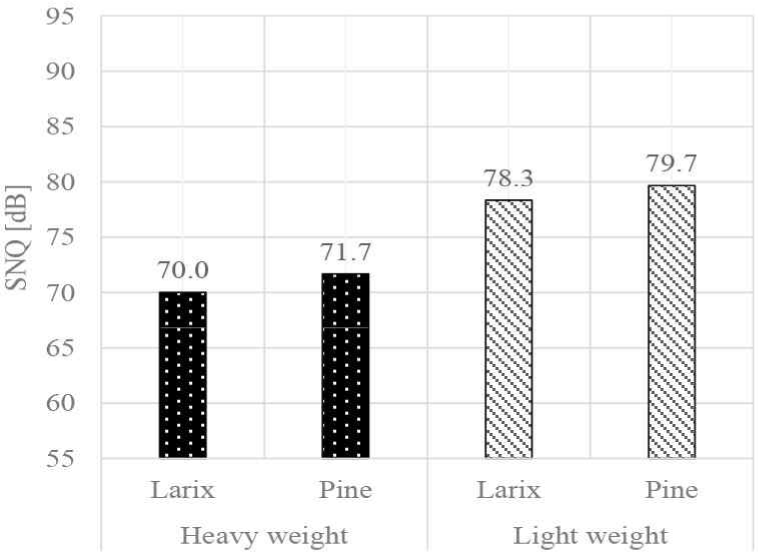
Fig. 11 presents the measured values of heavy-weight and light-weight floor impact sounds by frequency. In the case of 150 mm half-lap joint, the variation ranged from 1 to 3 dB by frequency. However, similar to Fig. 10, the difference amounted to only approximately 1 dB in terms of single-number quantity. Therefore, in future domestic CLT production, L. kaempferi and P. densiflora are expected to be interchangeable with respect to sound insulation performance.
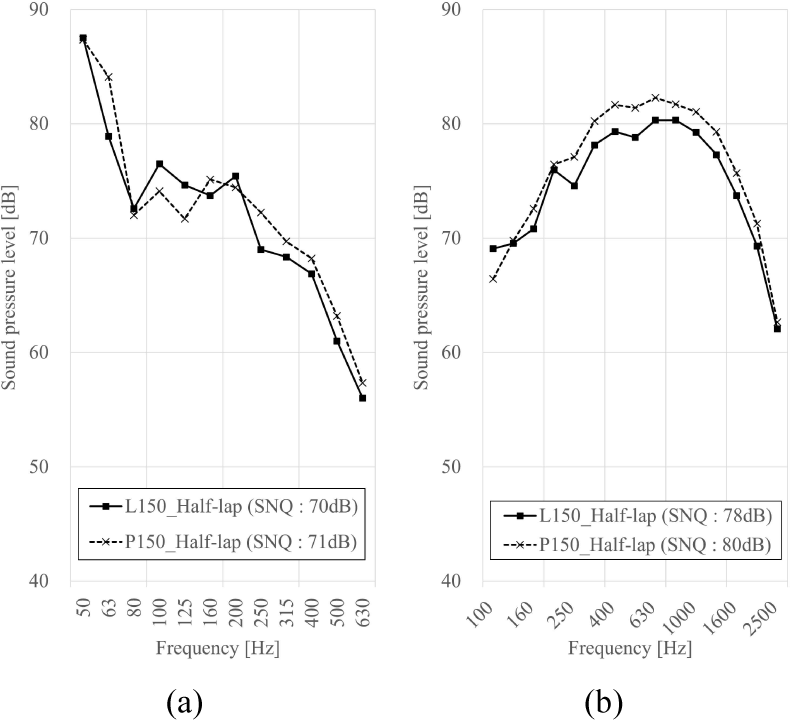
In a previous study investigating the effect of increasing panel thickness, a reduction of 2 dB was observed in heavy-weight floor impact sound upon increasing the concrete slab thickness by 30 mm (Jeon et al., 2006). To quantify the effect of increasing the CLT panel thickness, the CLT slabs were stacked from 1 to 2 and 3 layers to change the thickness from 150 mm to 300 and 450 mm. Considering that the experiment focuses not on the strength of CLT slabs but on sound insulation, the CLT slabs were stacked without using any additional fasteners to increase the thicknesses.
As presented in Table 3, the single-number quantity for heavy-weight floor impact sound was 69 dB at 150 mm. The LiA,Fmax was 63 dB at 300 mm, indicating a reduction of ~6 dB, and 59 dB at 450 mm, indicating a reduction of ~10 dB, compared to 150 mm. The single-number quantity for light-weight floor impact sound was 78 dB at 150 mm. The LnT,w was 67 dB at 300 mm, indicating a reduction of ~11 dB, and 62 dB at 450 mm, indicating a reduction of ~16 dB, compared to 150 mm.
| Designation | Heavy weight | Light weight |
|---|---|---|
| LS150 | 69 | 78 |
| L300 | 63 (∇6) | 67 (∇11) |
| L450 | 59 (∇10) | 62 (∇16) |
Based on the results, the correlation of CLT panel thickness with floor impact sound insulation performance was analyzed. As shown in Fig. 12, a 30 mm increase in thickness led to a ~1 dB reduction for heavy-weight floor impact sound and a ~1.6 dB reduction for light-weight floor impact sound. The effect of thickness differed between heavy-weight and light-weight floor impact sounds, with the latter showing a stronger influence. The measured values of light-weight floor impact sound include middle to high-frequency bands depending on the characteristics of the tapping machine as the impact source. In middle to high frequency, the short wavelength implies rapid energy consumption within the material, resulting in a stronger reduction effect compared to low frequency (David and Graf, 1979). Such variation in the level of reduction due to the characteristics of the impact source frequency was also observed for concrete slabs (Yeon et al., 2017). The pattern of reduction in middle to high frequency in this study is visible in Fig. 13, which presents the heavy-weight and light-weight floor impact sounds per frequency.
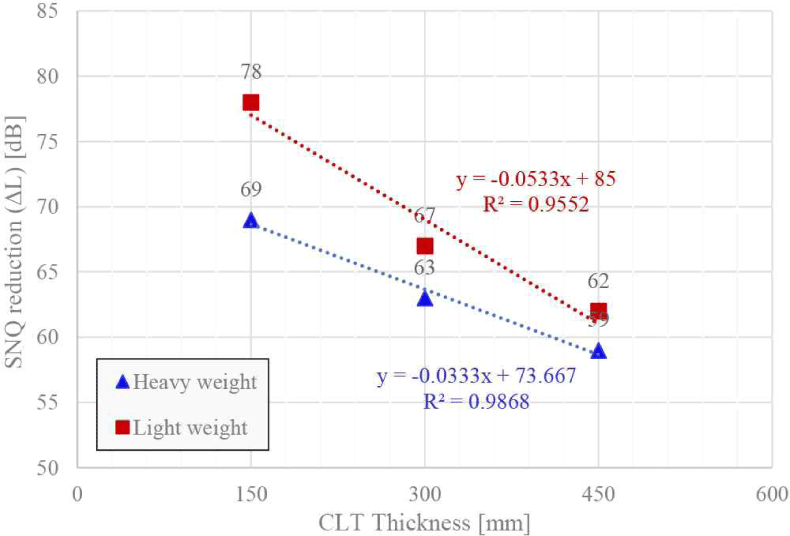
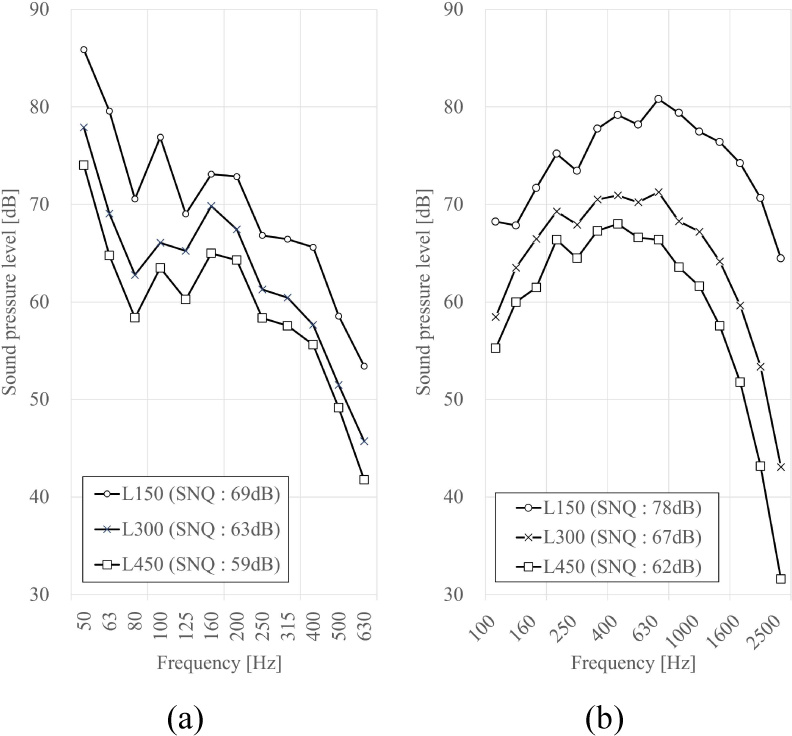
Analyzing the effect of thickness revealed that, in the case of CLT panels, increasing the thickness had low cost-effectiveness. Therefore, a more rational design approach would be to apply a resilient material for the mass-spring effect, where the CLT slab serves as the mass and the resilient material as the spring (Cremer and Heckl, 2013; Schiavi, 2018), or to adopt a hybrid structure with a concrete slab on the CLT, which has become popular recently (Hassan et al., 2019).
4. CONCLUSIONS
This study evaluated floor impact sound insulation performance under varying conditions through eight CLT floor experiments. The performance was measured in terms of single-number quantity and by frequency band, considering joint types (spline, half-lap, and butt), tree species (L. kaempferi and P. densiflora), and thicknesses (150, 300, and 450 mm). The main findings of this study are as follows:
-
Analyzing floor impact sound according to joint types revealed that the variation in sound insulation performance based on joint types was approximately 1 dB, which was insignificant. The minimal variation according to joint types is likely due to the fact that each CLT inter-panel joint, secured with screws, exhibited a single planar behavior.
-
Analyzing floor impact sound according to tree species showed that the two tested species varied in single-number quantity by only about 1 dB, indicating a lack of significant variation based on tree species. In future domestic CLT production, L. kaempferi and P. densiflora are expected to be interchangeable with respect to sound insulation performance.
-
Analyzing floor impact sound according to CLT thicknesses demonstrated that increasing the thickness by 30 mm reduced heavy-weight floor impact sounds by approximately 1 dB and light-weight floor impact sounds by approximately 1.6 dB.
As shown, this study provided a preliminary evaluation of the floor impact sound insulation performance of CLT floor slabs. The findings suggest that, rather than increasing CLT thickness, it may be more effective to use an additional buffer material or a hybrid panel that combines CLT and concrete in future CLT slab designs. This study is significant in providing fundamental data on the sound insulation performance of CLT using Korean domestic timber.

